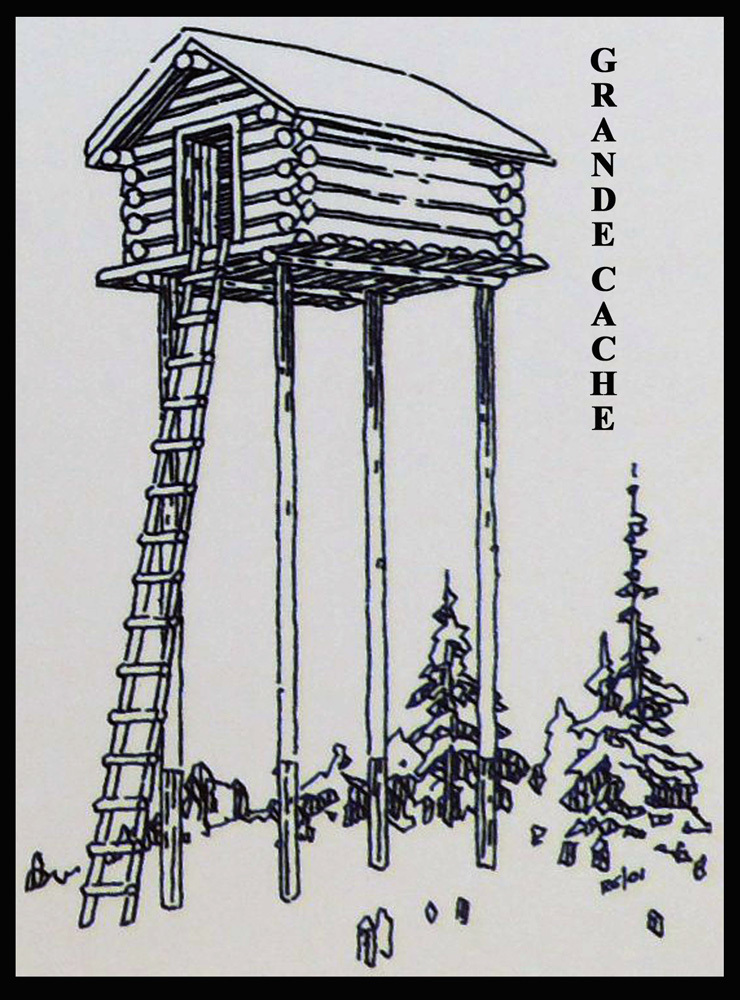
Consisting of a free museum, wildlife displays, Esson Gale Art Gallery and Bighorn Gallery Gift Shop, the Grande Cache Tourism Interpretive Centre was officially opened on October 5, 1996. The Tourism Interpretive Centre offers local and regional tourist information, maps and brochures.
Immediately south of the Tourism Interpretive Centre is Bird's Eye View Park, officially opened August 28, 2010. The park features interpretive trails and picnic areas with three gazebos. Here you can see a replica of a "cache” along with other historic buildings
that include the Muskeg Ranger Station built in 1942, Adams Creek Lookout built in 1940 and other buildings.
Under the "Grande Cache" and not far south of the large "
Welcome to Grande Cache" sign is a historical marker which relates some of the story of how the town of Grande Cache came to be named.
GRANDE CACHE
It's Our Name
IN A HISTORY OF GRANDE CACHE, renowned Canadian artist Robert Guest described a typical fur cache. "The cache was made from sturdy logs to withstand the severe winter conditions and the predators such as wolverines and bears, which might try to get inside. The cache was primarily used to store furs in winter, but could also be used for trapping supplies and perhaps dried or cured foods at times."
A Legacy Gift
In recognition of the 12 years Weyerhaeuser Company Limited operated in the community of Grande Cache (1992-2004), a donation of $50,000 was made to support the development of this project.
Weyerhaeuser hopes many travelers enjoy their visit and appreciate the history, beauty, and natural surroundings of the town as well as the outstanding hospitality offered by the citizens of Grande Cache.
Robert continued "The cabin was probably from five to eight feet tall in the centre, so a person could stand in it. The doorway was quite small. The stilts or legs of the cache had tin attached, so that animals would find it difficult to climb up into the cabin part of the cache. Winter caches of this type were usually about twenty feet above the ground."
Our town is called Grande Cache, which is of course French. The story on how we got that name is very interesting. Ignace Giasson was an Iroquois employee of the Hudson Bay Company who was stationed at St. Mary's Fort near Peace River. He was originally from the Montreal area, so he spoke French.
Giasson was active in the Grande Cache area during the years 1818 to 1821. He would travel into what is now British Columbia and bring back large quantities of furs. On one of these trips, he was heavily laden with pelts and the snow was very deep, so he constructed a winter fur cache on the banks of the Sulphur River, right below where Ewan Moberly later had his trading post at Victor Lake. Eventually, the whole area became known as Grande Cache.
By Richard Wuorinen for the Grande Cache Historical Society Sources: A History of Grande Cache and Pack Saddles to Tete Jaune Cache.
Thank you to Weyerhaeuser, Alberta Historical Resources Foundation and all who made this sign possible.
From the Historical Marker under The Cache